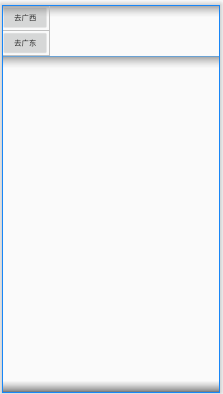您好,登錄后才能下訂單哦!
您好,登錄后才能下訂單哦!
Android studio 動態fragment的使用方法?很多新手對此不是很清楚,為了幫助大家解決這個難題,下面小編將為大家詳細講解,有這方面需求的人可以來學習下,希望你能有所收獲。
fragment的使用時Android的基礎,它有兩種用法,第一個就是靜態的fragment。第二個則是動態的fragment。
靜態fragment直接在layout創建你想要的fragment的XML的文件,然后在你的Java包里面創建對應fragment的class文件
布局代碼如下所示

<?xml version="1.0" encoding="utf-8"?> <LinearLayout xmlns:android="http://schemas.android.com/apk/res/android" android:layout_width="match_parent" android:layout_height="match_parent" android:orientation="vertical"> <TextView android:layout_width="match_parent" android:layout_height="wrap_content" android:text="歡迎來到廣西!"/> </LinearLayout>

<?xml version="1.0" encoding="utf-8"?> <LinearLayout xmlns:android="http://schemas.android.com/apk/res/android" xmlns:app="http://schemas.android.com/apk/res-auto" xmlns:tools="http://schemas.android.com/tools" android:layout_width="match_parent" android:layout_height="match_parent" android:orientation="vertical" tools:context=".MainActivity"> <Button android:layout_width="wrap_content" android:layout_height="wrap_content" android:text="去廣西" android:id="@+id/bt_anjian1"/> <Button android:layout_width="wrap_content" android:layout_height="wrap_content" android:text="去廣東" android:id="@+id/bt_anjian2"/> <LinearLayout android:layout_width="match_parent" android:layout_height="wrap_content" android:orientation="vertical" android:id="@+id/ll_rongqi" android:layout_weight="9"> </LinearLayout> <fragment android:layout_width="wrap_content" android:layout_height="wrap_content" android:id="@+id/fragment_1"/> </LinearLayout>
*這里需要注意一下,如果你不給fragment加個id,那你運行app的時候將會發生閃退現象。

package com.example.anyone_fragment_2;
import android.os.Bundle;
import android.view.LayoutInflater;
import android.view.View;
import android.view.ViewGroup;
import android.widget.Button;
import androidx.annotation.NonNull;
import androidx.annotation.Nullable;
import androidx.fragment.app.Fragment;
public class Fragment_1 extends Fragment {
@Nullable
@Override
public View onCreateView(@NonNull LayoutInflater inflater, @Nullable ViewGroup container, @Nullable Bundle savedInstanceState) {
View view=inflater.inflate(R.layout.fragment_1,container,false);
return view;
}
}這樣靜態fragment算是弄好了,但是這次我們主要討論動態fragment的用法
首先,我們先在activity_main中寫下如下代碼
<?xml version="1.0" encoding="utf-8"?> <LinearLayout xmlns:android="http://schemas.android.com/apk/res/android" xmlns:app="http://schemas.android.com/apk/res-auto" xmlns:tools="http://schemas.android.com/tools" android:layout_width="match_parent" android:layout_height="match_parent" android:orientation="vertical" tools:context=".MainActivity"> <Button android:layout_width="wrap_content" android:layout_height="wrap_content" android:text="去廣西" android:id="@+id/bt_anjian1"/> <Button android:layout_width="wrap_content" android:layout_height="wrap_content" android:text="去廣東" android:id="@+id/bt_anjian2"/> <LinearLayout android:layout_width="match_parent" android:layout_height="wrap_content" android:orientation="vertical" android:id="@+id/ll_rongqi" android:layout_weight="9"> </LinearLayout> </LinearLayout>
布局效果圖是這樣的

這里fragment的XML文件和開頭所說的靜態fragment的那個XML文件的寫法是一樣的
同理,fragment對應的class文件也是相同的。
package com.example.anyone_fragment_2;
import androidx.appcompat.app.AppCompatActivity;
import androidx.fragment.app.Fragment;
import androidx.fragment.app.FragmentManager;
import androidx.fragment.app.FragmentTransaction;
import android.os.Bundle;
import android.view.View;
import android.widget.Button;
public class MainActivity extends AppCompatActivity implements View.OnClickListener {//有abstract就閃退
private Button bt_anjian1,bt_anjian2;
private Fragment Fragment_1,Fragmentnow,Fragment_2;
private FragmentManager fragmentManager;
private FragmentTransaction fragmentTransaction;
@Override
protected void onCreate(Bundle savedInstanceState) {
super.onCreate(savedInstanceState);
setContentView(R.layout.activity_main);
chushihua();
shilihua();
}
private void chushihua()
{
bt_anjian1=findViewById(R.id.bt_anjian1);
bt_anjian2=findViewById(R.id.bt_anjian2);
bt_anjian1.setOnClickListener(this);
bt_anjian2.setOnClickListener(this);
}
private void shilihua(){
//用于實例化fragment
Fragment_1=new Fragment_1();
Fragment_2=new Fragment_2();
Fragmentnow=Fragment_1;
fragmentManager=getSupportFragmentManager();
fragmentTransaction=fragmentManager.beginTransaction();
//38:只要你要對fragment進行操作就少不了這句 原來的寫法是FragmentTransaction fragmentTransaction=fragmentManager.beginTransaction();
fragmentTransaction.add(R.id.ll_rongqi,Fragment_1).commit();
}
public void onClick(View vv)
{
fragmentTransaction=fragmentManager.beginTransaction();
switch (vv.getId())
{
case R.id.bt_anjian1:if (Fragment_1.isAdded())
{
fragmentTransaction.hide(Fragmentnow).show(Fragment_1).commit();
}
else
{
fragmentTransaction.hide(Fragmentnow).add(R.id.ll_rongqi,Fragment_1).commit();
}
Fragmentnow=Fragment_1;
break;
case R.id.bt_anjian2:if(Fragment_2.isAdded())
{
fragmentTransaction.hide(Fragmentnow).show(Fragment_2).commit();
}
else
{
fragmentTransaction.hide(Fragmentnow).add(R.id.ll_rongqi,Fragment_2).commit();
}
Fragmentnow=Fragment_2;
break;
}
}
}下面來分析一些地方
初始化功能函數
private void chushihua()
{
bt_anjian1=findViewById(R.id.bt_anjian1);
bt_anjian2=findViewById(R.id.bt_anjian2);
bt_anjian1.setOnClickListener(this);
bt_anjian2.setOnClickListener(this);
}這樣寫的目的是讓代碼可讀性更好,不至于很混亂。
其次就是實例化我們所寫的fragment功能函數
private void shilihua(){
//用于實例化fragment
Fragment_1=new Fragment_1();
Fragment_2=new Fragment_2();
Fragmentnow=Fragment_1;
fragmentManager=getSupportFragmentManager();
fragmentTransaction=fragmentManager.beginTransaction();
//38:只要你要對fragment進行操作就少不了這句 原來的寫法是FragmentTransaction fragmentTransaction=fragmentManager.beginTransaction();
fragmentTransaction.add(R.id.ll_rongqi,Fragment_1).commit();
}其中的
FragmentManager fragmentManager;
這個是fragment和activity交互所要用到的。
fragmentManager=getSupportFragmentManager();
固定寫法。
而
private FragmentTransaction fragmentTransaction; fragmentTransaction=fragmentManager.beginTransaction();
是調動fragment操作的API,也必不可少。
fragmentTransaction.add(R.id.ll_rongqi,Fragment_1).commit();
是添加fragment所用的語句,在這里就相當于是初始化吧。add(容器id,碎片對象),commit則是提交。
public void onClick(View vv)
{
fragmentTransaction=fragmentManager.beginTransaction();
switch (vv.getId())
{
case R.id.bt_anjian1:if (Fragment_1.isAdded())
{
fragmentTransaction.hide(Fragmentnow).show(Fragment_1).commit();
}
else
{
fragmentTransaction.hide(Fragmentnow).add(R.id.ll_rongqi,Fragment_1).commit();
}
Fragmentnow=Fragment_1;
break;
case R.id.bt_anjian2:if(Fragment_2.isAdded())
{
fragmentTransaction.hide(Fragmentnow).show(Fragment_2).commit();
}
else
{
fragmentTransaction.hide(Fragmentnow).add(R.id.ll_rongqi,Fragment_2).commit();
}
Fragmentnow=Fragment_2;
break;
}
}這里的onClick的名字是不能改變的,否則你button沒辦法觸發。
用傳來的形參View vv來獲取到我們所點擊的按鈕來判斷操作。
思想就是,如果Fragment存在,則只需要把它展示出來即可。isAdded嘛,ed過去式,那就是代表存在過咯。
若是沒有,則添加就好。
看完上述內容是否對您有幫助呢?如果還想對相關知識有進一步的了解或閱讀更多相關文章,請關注億速云行業資訊頻道,感謝您對億速云的支持。
免責聲明:本站發布的內容(圖片、視頻和文字)以原創、轉載和分享為主,文章觀點不代表本網站立場,如果涉及侵權請聯系站長郵箱:is@yisu.com進行舉報,并提供相關證據,一經查實,將立刻刪除涉嫌侵權內容。